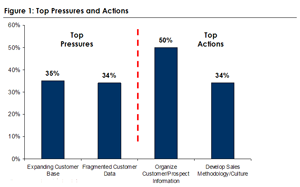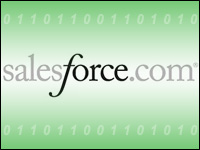
The proliferation of customer relationship solutions presents an interesting challenge for small-business owners. How does a small organization looking to control spending decide between common productivity tools, such as Microsoft Outlook or Excel, or a more robust solution? This decision is made more difficult by the emergence of free customer relationship management (CRM) and contact management (CM) solutions.
Both CRM and CM tools are productivity tools that allow businesses to organize contact, opportunity and account information in a centralized repository. In the case of CRM, organizations are also able to integrate disparate customer data that exists with marketing and customer service and support channels. The documented business benefits of both CRM and CM tools have some small and medium-sized businesses evaluating free solutions to alleviate their specific business challenges.
Free solutions can take the form of a “freemium” solution or other existing productivity tools, such as spreadsheets or email. Freemium solutions, for instance, provide basic functionality on a trial, controlled usage, or ad-supported basis. The freemium model was conceived with the eventual goal of selling a premium solution that would expand on the basic functionality of the freeware. Naturally, small businesses are enticed by a free solution and its “try before you buy” model. However, companies must be sure to balance their immediate needs with the growth of the business by evaluating full-featured CRM or CM tools in conjunction with free offerings.
Taming Information Overload
Companies continually encounter economic, regulatory or operational business challenges, or “pressures,” pertaining to their business or industry. Economic or regulatory forces, for instance, can cause organizations of all shapes and sizes to be challenged by the same issues. However, the strategies that companies enact to alleviate business pressures are often very different and ultimately determine a company’s ability to respond effectively to challenges. Figure 1 reveals the top two business challenges CM users encounter, as well as the top strategies in place to reduce these pressures.
Aberdeen research reveals that 35 percent of CM users cited their expanding customer base as a top-two business challenge causing them to automate sales interactions. Furthermore, 34 percent of CM users were challenged by fragmented customer data. These two business challenges are not mutually exclusive; it stands to reason that the larger and more complex a business becomes, the greater likelihood there is for additional fragmented customer data. The relationship between these two business challenges also suggests the need for solutions that are able to scale with the growing business needs of their users.
Fifty percent of CM users indicated that organizing customer and prospect information is a “top-two” strategic action to alleviate the pressures associated with an expanding customer base and data stream. Naturally, companies should organize and centralize customer and prospect information to provide some semblance of internal visibility to sales operations and protect against losing data assets to employee turnover. Furthermore, by tying all pertinent account or specific customer information to a contact record, companies are able to organize and centralize all interactions and better understand the customer experience. The productivity tools companies currently leverage to organize such information, such as spreadsheets and email, are typically labor intensive and not conducive to collaboration.
Manual Methods for Organizing Outreach
For small businesses without a defined CM, email and spreadsheets typically serve as the primary forms of contact management. Of the 260 total respondents to a 2008 Aberdeen survey, 77 percent indicated they used Microsoft Outlook for contact management, while 30 percent used a sales force automation (SFA) tool.
The advent of free solutions has provided these companies with another alternative; however, the streamlined features that small-to-medium businesses require are often included with a “premium” solution. Forty-seven percent of respondents indicated that integrating sales and marketing processes is a top-two strategy for supporting sales force automation initiatives.
The use of an integrated CM solution allows businesses to manage account and contact information and history, as well as send targeted email messages to specific customer segments. The reliance on spreadsheets and email systems for account management does not allow for such a unified sales and marketing outreach.
Freemium: The Good, The Bad and The Costly
The freemium business model, occasionally referred to as the “pay as you grow” or “value-tiered” model, operates under one simple assumption: If customers truly value the basic product or service a company delivers, then they are willing to pay for additional offerings or functionality. The growth in popularity of certain consumer-focused freemium solutions, such as VoIP providers or online photo-sharing services, has legitimized the model as one that can attract and retain customers.
However, there is a difference between what users are willing to experiment with in their personal lives and what they’ll decide to do for the overall well-being of their business. Free solutions are often a valuable learning experience for end-users deciding which features and functionality are most valuable to their organization.
Table 1: Contact Management Solution Types
Solution TypeDefinitionsConsiderationsPersonal InformationManagement (PIM)Software that providesbasic information management functionality, such as calendar,address book and light contact management. Microsoft Outlook andLotus Notes are examples.Companies leveraging aPIM solution as the primary form of contact management can oftensuffer from “information overload.” Unorganizedin-boxes, for instance, can make it hard for employees to find themessages or notes they need quickly and easily.“Freemium”Contact Management (FCM)Contact managementsolutions that provide basic CM functionality on a trial,controlled usage, or ad-supported basis. FreeCRM and Zoho areexamples.The “try beforeyou buy” allows businesses to experience the benefits of a CMsolution and evaluate the features necessary for daily operations.However, businesses must establish who owns the data and develop acontingency plan in the event the FCM does not scaleappropriately.Contact Management(CM) SolutionA productivity tooldesigned to manage contacts, opportunities, accounts, andinteraction notes. Act by Sage and Microsoft’s BusinessContact Manager are examples.A CM solution iscrucial for companies with multiple sales representatives,accounts, and opportunities. CM solutions allow businesses toorganize sales outreach, while a CRM solution may be a better fitfor companies looking to unify sales, marketing, and customerservice and support efforts.
- The Good: For a small-business owner examining ways to organize sales outreach and document conversations and contact information, a CM solution provides all the necessary functionality (Table 1). CM solutions allow users to manage opportunities, accounts and contacts, as well as centralize meeting and conversation notes for the benefit of the entire organization. Several freemium contact management (FCM) solutions are adept at providing modest functionality to business owners who are experimenting with a CM solution or are just starting out. The “try before you buy” model allows businesses to develop a comfort level with an FCM tool and determine what features meet their specific needs.
- The Bad: Companies trying to break their reliance on Microsoft Outlook and Excel as their organizations’ primary information management systems may be intrigued by a freemium solution at first. However, the risk remains that the company will migrate back to laborious, manual practices if it should encounter usage caps or contact caps. Furthermore, the limited functionality of some FCM tools does not allow companies to execute on their sales and marketing initiatives as planned. Finally, the disruptive advertisements of some FCM tools can become a nuisance that affects productivity.
- The Costly: The cost of a solution (64 percent) was identified by survey respondents as one of the “top-two” criteria used to select a solution provider, right behind the ability to demonstrate success in similar projects (69 percent). Organizations are focused on every expenditure and the impact each expense may have on the business, particularly in a challenging economic climate. As a way of cutting costs, some small businesses may opt for an FCM solution to organize prospect and customer information. The “try as you buy” model provides a no-risk safety net for small businesses searching for the tool that best fits the needs of the organization. However, companies must remember that what is free now may prove to require extensive resources to support down the road. Once a company has reached its usage limit, it must decide whether or not to upgrade to a premium model or move to another CM solution. The time and productivity wasted migrating customer information from one system to another eventually eats into the resources that were perceived to be saved through the implementation of a free solution.
Case in Point
American Health Insurance, headquartered in Northridge, Calif., is an independent health insurance agency that works with Blue Cross/Blue Shield in several states. Founded in 2003 by Chuck Mondrus, American Health Insurance at first focused exclusively on California before branching out into Colorado, Nevada and Georgia. Even though the company has just 10 employees, the list of business contacts exceeds 80,000, making it one of the largest health insurance companies in the country. As a result of this vast amount of customer data, Mondrus quickly realized the need for a contact management solution that would give them visibility into the business. “Quite simply, Act by Sage keeps us on task,” begins Mondrus. “I can take a snapshot in any point in time of where I am in my business; using the ‘Groups’ function, I can organize contacts that were sold in a particular month, look at the performance of my sales representatives, see how the billing takes place, and keep tabs on customer emails.”
One of the biggest benefits for American Health Insurance is the ability to set reminders, or “ticklers,” regarding prospect outreach. “Our solution gives up the ability to set up automated alerts as to when to reach out to a prospect or customer,” says Mondrus. “In my line of work, we are always trying to get a hold of people to answer questions or provide quotes; our solution helps us balance the outreach to our older contacts versus our newer ones.”
Since American Health Insurance generates demand online, it needed a system that could integrate the contact information it captures online directly into the solution. For example, online prospects often provide contact information to get free online quotes. Once they’ve done so, American Health Insurance is automatically notified. “An email is sent to me through a secondary service that takes that new contact information and imports it directly into our Act fields. Act then sets a reminder for me to follow up with that contact after a certain amount of time,” says Mondrus.
Like many business owners, data security is a huge point of concern for Mondrus. As a result, American Health Insurance opts to house its customer data on an internal server. “Personally, I’m wary of having my data online on someone else’s server. As a result, that issue eliminates any online contact management solution, free or not, that forces me to house my data on a separate server.” Mondrus’ concern pertains not just to data security, but also data ownership. With over 80,000 contacts in the database, American Health Insurance prefers a customizable contact management solution.
For companies deciding which contact management solution fits their specific needs, Mondrus offers up some advice. “Obviously, you need a program that can be accessed by multiple users and a server with enough storage,” concludes Mondrus.
Key Takeaways
For organizations evaluating both free and paid CM solutions, there are a few key takeaways that should be considered.
- Weigh your current business needs against future growth. Freemium solutions are an enticing option for small or new businesses. However, companies must evaluate the ability of the solution to grow with the business. Free solutions may indeed be the most cost-effective option in the short term. As a company grows and takes on a larger number of customers and contacts, though, the complexity of operations and amount of fragmented customer data are likely to increase. Companies must be sure that whichever solution they implement has the ability to address the short-term goals of the company as well its plans for growth.
- Empower sales to sell. With the ability to extend CM and Customer Relationship Management (CRM) solutions through add-ons, plug-ins, and complementary products, such as an integrated sales intelligence solution, organizations are finding ways to reduce the amount of time sales representatives spend searching for information and enabling them to sell. For small and mid-sized organizations, a CM solution serves a similar purpose. By centralizing contact, account and opportunity information, organizations can reduce the amount of time employees spend on the administrative tasks associated with email and spreadsheet reliance.
- Be clear on who owns the data. Prospect contact information is valuable information to any company; therefore, organizations considering freemium solutions should be certain they can migrate data to another solution if they choose, or that their data is protected in the event the provider folds.
- Free is only free if you don’t value your own time. There is typically a cost associated with the implementation, support and customization of a paid CM solution. However, the additional services that are necessary to be successful, such as training, live support, and Service Level Agreements (SLAs), are incorporated in these costs. In the case of a freemium solution, a lack of proper documentation, such as an operator’s manual, support or training, can become a drain on an organization’s time and productivity. What once appeared to be a free solution can become more costly as businesses struggle with a lack of visibility into the vendor and an absence of add-on developer kits and implementation partners. For some organizations, the time spent developing training curriculums, struggling with support issues, or attempting to customize a solution can outweigh the benefits of a free solution. Furthermore, the time devoted to laborious and time-consuming tasks using spreadsheets can also be a drain on organizational resources.
Alex Jefferies is a senior research associate for Aberdeen Group’s customer management technologies group.





















































Social CRM
See all Social CRM